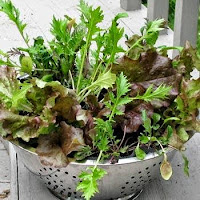Lettuce is a leafy vegetable
that is grown annually in outdoor gardens, or containers. Lettuce is mostly used for salads or as a
garnish for a sandwich. This nutritious
vegetable is rich in vitamin A and potassium.
Lettuce can be grown indoors, outdoors in a garden bed, or in a
container. If you plan on growing lettuce outdoors then provide your lettuce with a minimum of six hours of sun.
Instructions for Growing Lettuce
When to plant:
Plant lettuce in the spring; mid-March for seeds and if you
intend to grow seeds indoors and transplant outdoors then plant the seedlings
in early April. For your fall lettuce
crop plant mid to late August for bib lettuce and July to August for romaine
lettuce.
Sowing Seeds:
Plant lettuce seeds by sowing them in a prepared garden
bed. Set the lettuce seed on the soil and then
use the eraser end of a pencil to push the seed ¼ inches into the soil. Plant the seeds 15 inches apart. Water well after all the seeds have been
planted.
Transplanting Seedlings:
Grow lettuce seedlings in rows in the garden bed; dig a hole
that is as deep as the root. Set the
seedling in the hole and cover the root ball with dirt. Firm the soil around
the stem. Space the lettuce seedling 15
inches apart and water well.
Caring for Lettuce:
Keep newly planted lettuce seeds and transplants
hydrated. Do not let the soil dry out as
it will cause stress on the plant. It is
best to keep the soil evenly moist by not wet.
Water lettuce plants in the morning.
Warning if you have heavy soil and overwater the lettuce then it will
rot.
Harvesting Lettuce
Harvest the lettuce leaves in the morning before the sun is
high in the sky. I like to cut the lettuce heads early in the morning at the soil
level. I will harvest lettuce when the
dew is still on the leaves. I like to
believe that this is when the lettuce is not under stress and the leaves have
the best flavor.
For leaf lettuce, I will cut off
large leaves and leave the lettuce head intact.
That way it will continue to grow.
Wash the lettuce to remove the
dirt from the leaves. If the leaves are
damaged then remove these leaves from the head after the leaves are clean put them in an air-tight container and refrigerator before the leaves wilt.
Lettuce Tips:
Type: Annual
Planting Depth: 1/4"
Thin to: 4"
Light: Sun
Days to germination: 10-15
Maturity: 45-50 Days
Planting Depth: 1/4"
Thin to: 4"
Light: Sun
Days to germination: 10-15
Maturity: 45-50 Days



